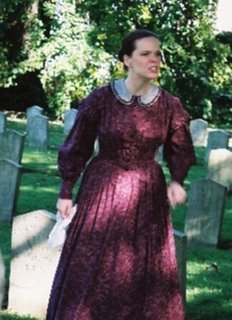
“When in the Course of human events it becomes necessary for one people to dissolve the political bands which have connected them with another and to assume among the powers of the earth, the separate and equal station to which the Laws of Nature and of Nature's God entitle them, a decent respect to the opinions of mankind requires that they should declare the causes which impel them to the separation.”
You may recognize these words as those of Thomas Jefferson, and the opening paragraph of the Declaration of Independence. They were also the words uttered by Liz Angle as she greeted us in her role as Alice Whiting Waterman at the final stop on this year’s tour, Confederate Rest.
Confederate Rest is the northernmost Confederate graveyard and is located within Forest Hill Cemetery. 140 of the thousand plus Confederate POWs sent to Camp Randall are buried here. All but one died within weeks of their arrival, sick as they were with pneumonia or other diseases. The people of Madison turned out with bands to greet the train carrying the first load of prisoners, most of whom were part of the 1st Alabama Infantry captured at Island No. 10 in the Mississippi River. Others captured were members of the 1st Alabama, Tennessee & Mississippi Regiment. The sickest of the prisoners were ferried north via boat, the train being deemed too risky for their health, yet men who were already suffering from pneumonia or serious battle wounds were left lying on an open deck, exposed to the harsh wind and rain of a northern spring. Citizens brought food, clothing and reading material to prisoners daily, and attended the sick as best they could, but many were too far gone to recover, and were laid to rest in a “potter’s field” at Forest Hill.
Though she knew none of them, Alice felt a deep affinity for her fellow southerners, though she herself had lived in the north since the age of ten. These 140 were “her boys.” She held them in great esteem for the depth of their convictions, right or wrong, for these boys — and many of them were mere boys — believed wholeheartedly in the cause for which they fought and died, and were the embodiment of the words of Thomas Jefferson.
When Alice Whiting Waterman arrived in Madison in 1868, six years after these Confederate soldiers were laid to rest, she found their graves overgrown with weeds and fallen in disrepair. She fell to her knees to pull weeds and returned, day after day, until she had completely cleared the tiny plot, for no matter what side they were on, they deserved better than this in death. She planted hickory trees to protect their graves from the heat of summer and harsh winter winds. With the assistance of Lucius Fairchild, she raised funds to build a wooden fence around the plot, later replaced with a low stone wall, and saw that the worn wooden “headboards” were replaced with stone markers containing name, company, regiment, state and date of death. Alice diligently tended her boys for thirty years, and was laid to rest along side them, as was her final request. Following her passing in 1897, Rev. J.W. Cochran, of Christ Presbyterian Church, paid tribute to Alice Waterman as a prelude to his Sunday sermon, and can be read here.
This was the same year that Madison first celebrated Memorial Day. All businesses closed for the day, and citizens marched en masse to the cemetery for ceremonies honoring the fallen that became a tradition. It was four years later that the “misguided ‘boys in gray’” were included in a speech by Governor Cadwallader C. Washburn, who had been a Union general at Vicksburg. Following ceremonies for the Union fallen, he urged all citizens to accompany him to Confederate Rest to pay their respects to “those who sleep so far away from their once sunny and happy homes.” It was one of the earliest reconciliations between North and South, and they are still honored along side Union fallen in a sunrise ceremony each Memorial Day.





5 comments:
Sounds like you had a blast on this tour and learned a lot of neat stuff.
The story of Alice Whiting Waterman is very moving. Thanks for sharing this, and the previous stories. :-)
I did indeed! I'm glad you've enjoyed reading about it - thanks, Jana!
And yes, I know - once again you're jealous of all the neat stuff going on around here. But hey - YOU work in historical archives all the time, so there! Can't tell me you've never gleaned some interesting tidbits from all the sorting and cateloging you do. *wg*
I would like to thank the people of Madison for remembering and caring for the Boys in Grey every Memorial Day. The story of Alice W. Waterman and what she did for "Her Boys" is very moving. Robert Knight of the Maj. Gen. Isaac Ridgeway Trimble Camp # 1836 Sons Of Confederate Veterans Maryland Division
I just learned something new! Thanks for sharing this. She sounded like an amazing woman.
Robert - preserving history is very important to many up here. Thank you for visiting and leaving a comment!
Shelli - She was indeed a remarkable woman. Thanks for checking out the cemetery posts!
Post a Comment